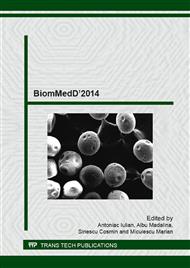p.47
p.54
p.62
p.67
p.73
p.79
p.85
p.91
p.98
New Flexible Cyanoacrylate Tissue Adhesive Adhflex®: Adhesion and Performance in Inguinal Hernia Repair
Abstract:
Sutures and cyanoacrylate high strength tissue adhesives are commonly used for wound closure in several surgical applications. Although effective for closing simple and small incisions, cyanoacrylate adhesives were limited by compromising adhesion and stiffness, i.e. cyanoacrylates with short alkyl chain length showed higher adhesion but lower flexibility than the ones with long alkyl chain length. In this paper, a new concept of flexible and high strength tissue cyanoacrylate based adhesive - Adhflex®- is presented. The balance between adhesion and flexibility in Adhflex® was achieved by adding an inert (i.e. non-reactive) chemical to a short alkyl chain length cyanoacrylate able to partially inhibit its polymerization in presence of moisture. Adhesion properties of Adhflex® were superior as compared to other commercial cyanoacrylate tissue adhesives (i.e. higher traction and shear strength). Furthermore, Adhflex® has been successfully used in a clinical trial for inguinal hernia repair (case study) as the surgery time with respect to suturing was reduced substantially, the comfort of the patient was improved (i.e. reduced tension after surgery, reduced allergic reaction) and the scare was minimal.
Info:
Periodical:
Pages:
73-78
Citation:
Online since:
March 2015
Keywords:
Price:
Сopyright:
© 2015 Trans Tech Publications Ltd. All Rights Reserved
Share:
Citation:


